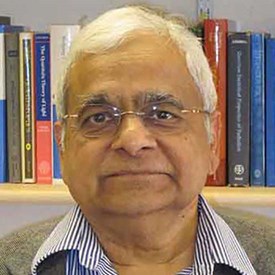Distinguished QuCoLiMa Guest Talk: Prof. Girish Agarwal – Time Reversed Quantum Metrology using Squeezed States of Light and Matter
This week, Prof. Girish S. Agarwal from Texas A&M University will be visiting Erlangen. During his stay, Prof. Agarwal will give a Distinguished QuCoLiMa Guest Talk on Thursday, March 16, at 11:00 about
Time Reversed Quantum Metrology using Squeezed States of Light and Matter
It is now well appreciated that quantum physics can be used to build better sensors. Such sensors belong to two classes: (a) those where the dynamical evolution of the system is unitary as is the case for the estimates of the phase and displacements or forces, (b) open systems whose evolution is described by the master equation as is the case for scattering and lossy transmission channels. The framework of the quantum Fisher information enables one to obtain best estimates of the parameters and then one can design possible experiments that can reach Cramer-Rao bounds. I would bring out not only the importance of the quantum states used as probes, but also the importance of the ‘quantum’ measurement schemes. The time reversed metrological arrangements for both unitary and open systems are very special as in many cases such time reversed measurements can reach Cramer-Rao bounds. I would illustrate the ideas, using both squeezed states of light and matter, for unitary as well as open systems.
The talk will be in presence in lecture hall H in Erlangen and live-streamed via Zoom:
www.qucolima.de/join-qucolima-talk
Short CV
Girish S. Agarwal received his PhD from the University of Rochester, USA. He is currently a University Distinguished Professor at Texas A&M University. He is an authority on Quantum Optics. He has published more than 700 papers and authored two books on quantum optics. He is a Fellow of The Royal Society, UK; Optical Society of America, the American Physical Society, the Indian National Science Academy, and The World Academy of Sciences (TWAS). His work has been recognized by the OPTICA’s Max Born Award and the C. H. Townes Medal, the TWAS Award in Physics, and the Humboldt Research Award.

